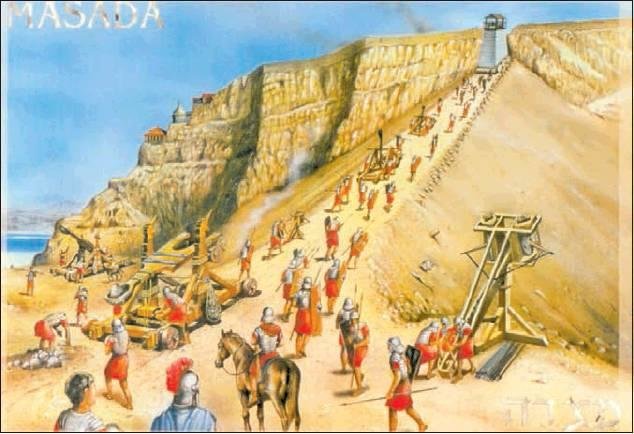Roman ingenuity ends the siege at Masada
Chronicle Editor Emeritus Jerry Bellune shares with you his adventures in the Holy Land. The experience gave him a greater appreciation of shared US and Israeli values.
IMasada, Judea
…
This item is available in full to subscribers.
Subscribe to continue reading. Already a subscriber? Sign in
Get 50% of all subscriptions for a limited time. Subscribe today.
Please log in to continueNeed an account?
|
Roman ingenuity ends the siege at Masada
Chronicle Editor Emeritus Jerry Bellune shares with you his adventures in the Holy Land. The experience gave him a greater appreciation of shared US and Israeli values.
IMasada, Judea
magine you are one of the Sicarii rebels on the desert fortress at Masada. You had stored food and water for what you thought would be all you would need to outlast the Roman legion below you.
Months had dragged into 3 years and the Romans would not give up.
Now imagine you are Roman Governor Lucius Flavius Silva. You have the 10th Legion – 8.000 fierce warriors – and another 7,000 Jewish slaves and auxiliary forces and suppliers.
You have to answer to your masters in Rome as to why you have not yet seized Masada and taken the Jewish rebels as prisoners.
The revolt begins
All of this began in what we believe was 66 AD, more than 30 years after the death of Jesus.
The Great Jewish Revolution had begun. A group of Jewish zealots captured the isolated fortress King Herod had built on top of Masada.
After Governor Silva’s men had taken Jerusalem and destroyed the 2nd Temple, more refugees fled to Masada, quickly followed by the Roman legion.
As they had done in Gaul and the British isles, the legion was determined to crush the rebellion and enslave all of the Jews.
Silva would have surveyed the terrain, chosen the weakest point at which to attack and ordered his artisans and carpenters to build their largest weapons.
He also had to find provisions to feed and shelter about 15,000 people
And his slaves would have been forced to build a wall to ensure no enemies escaped and cover his back.
Roman siege weapons
Silva set up 8 camps at the foot of Masada for his 15,000 soldiers and slaves.
When his plan to starve the Jews off Masada didn’t work, he turned to his weapons including:
• The Ballista, a huge crossbow that could fire large stones the length of more than 3 football fields.
• The Catapulta that could fling fire bolts.
• The Grapple, a large metal hook used to pull down fortress walls.
• The Wild Ass to fling stones from a basket. It required 8 men to operate it and a solid base to give the apparatus stability.
Vitruvius, a Roman author of architecture and engineering, tells us that there were 10 Wild Ass weapons for each legion and that stones as heavy as 360 pounds were used.
The great ram
For 3 years the zealots held off the Roman troops.
The final, successful weapon was a battering ram.
The ram was probably a stout tree trunk, tipped with iron and hung on chains to be swung back and forth.
To place it high enough to reach the fortress walls, slaves had to build an earthen ramp up the western face of Masada. The Romans believed the zealots would not thrown stones at other Jews.
By 73 AD, the ramp was complete and the battering ram hauled up to breach the fortress walls Herod had built around Masada’s top.
After the Romans broke through the outer walls they faced a wooden inner wall the rebels had hastily built.
The Romans set fire to it.
With the desert wind in their favor, the wooden wall came down and the Romans entered the fortress, armed with their swords.
Most of what we know about the siege of Masada comes from Roman-era historian Josephus Flavius and from archeological discoveries at Masada.
When I visited Masada with other journalists 2,000 years later, we could see the Roman ramp and the interior of the desert fortress.
Next I will tell you about what surprised the Romans when they broke through and entered the fortress.
Other items that may interest you







Comments
No comments on this item Please log in to comment by clicking here